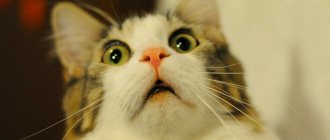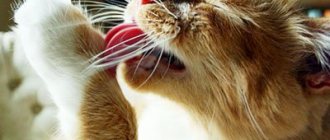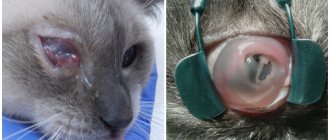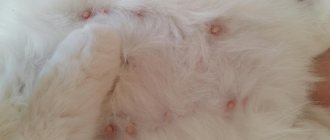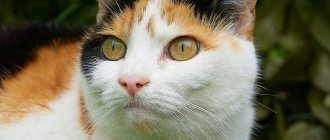Home » Useful Information
Each cat's eye color is unique in its own way. It can depend on breed, genetics and age: everyone knows that all little kittens have blue eyes. But why does this happen and how does eye color change?
- 2 When kittens change eye color
- 3 Eye color standards
- 4 What is heterochromia
Development of kittens (+ table)
Development of kittens (+ table)
Kittens are born small (weight 60-115 g, average body length 12 cm) and completely helpless, blind and deaf; all they can do is find their mother’s nipples, sleep and suck.
They cannot even get rid of excrement products on their own; to do this, the cat licks the appropriate places for them and eats their feces. However, they grow and develop quickly, and watching this process is a fascinating activity! Already a few days after birth, kittens begin to “knead” their mother’s belly with their paws, stimulating the secretion of milk (I wonder who taught them this?) They try to crawl, helping themselves with their front paws. At the age of seven days, a kitten can already crawl several tens of centimeters. At approximately 10-14 days of age, kittens' eyes begin to open.
. At this age, the eye color of all kittens is blue; it will change to the final adult color (“rebloom”) later, at the age of 3 months. At the same time, the ear canal opens and the kittens begin to hear.
In the third week
of life, kittens begin to erupt milk teeth (later they will be replaced by permanent ones). Their vision and hearing improve and they begin to explore the world around them. By the end of the first month of life, they can sit, move quite confidently and learn to play with each other. At one month of age, kittens become interested in trying foods other than their mother's milk.
Kittens older than 4 weeks become even more active and strive for independence. If before this they mainly explored their “nest,” now they are trying to get out of it. The cat spends a lot of energy maintaining order in the family and putting the children in their place. But the activity of kittens is growing by leaps and bounds, although at this age they still do not stray far from their mother. At this time, you need to place a tray next to the nest so that, following the example of their mother, the kittens become accustomed to cleanliness and neatness. Kittens that have been taught to do their business in the litter box by their mother cat will not have any problems with the toilet in the future.
From a month to one and a half months, kittens are very active, learn to lick themselves, play with each other and with their mother, and begin to eat solid food. There is an idea that at this age they can already be taken away from their mother and transferred to new owners. However, this idea is fundamentally incorrect. It is at the age of 1-3 months that kittens watch their mother and learn everything from her. Up to two months, the cat continues to feed the kittens with her milk, which provides them with good immunity to diseases. Therefore, it is not recommended to give away kittens before 2.5-3 months.
.
Complementary feeding of kittens is carried out as follows
. At the age of three weeks, kittens can be offered to drink milk from a saucer (about one teaspoon). Then you can offer some kitten food (see feeding kittens here). After a couple of days, a little baby food should be added to dairy foods, and after another week, it is recommended to replace one daily feeding with a small amount of canned meat. One month old kittens are fed approximately 4 times a day, in addition to their mother's milk. Feed portions are gradually increased. At one and a half months of age, a kitten should eat approximately 3-4 teaspoons of food per feeding.
Upbringing
Purchasing a kitten usually begins with a reservation. Then, only from 2 months of age the animal can be given to new owners. Why do you have to wait so long? Kittens, like children, are connected with their mother for the first time after birth, and not only with food. Mom teaches them the first steps and many other things that are invisible to us humans. After 2-3 months, the kitten is ready to leave its mother and move to a new family to live independently. In addition, during these 3 months, breeders teach kittens the litter tray, diet and scratching post.
After the kitten has moved to a new home, it needs to continue to be raised. You need to feed your pet in one specific place and at the same time. After moving, the toilet must first be installed in a visible place for the kitten so that he understands that his litter box is with him. The tray should be gradually moved towards the toilet, and after some time the kitten will only go to its tray in the place where it is convenient for you.
Why do kittens' eyes change color?
Eye color in cats depends on the amount of coloring pigment. Therefore, the reason for the change in eye color is the accumulation of melanin in the eyeball during the development of the visual organs. However, blue color is a recessive trait, which is why eyes of this shade are very rare.
At the moment of embryo formation, there are approximately 3 dozen pigment centers in the body of the future kitten. Migrating throughout the animal’s body during its development, the bulk of them settle in the fur. At the same time, the eyes account for only a small proportion of pigments, which continue to accumulate after the kitten is born. In the process of their accumulation, a change in the color of the kitten’s eyes occurs.
Clinical signs
Early signs of nasal cancer in dogs and cats include unilateral nasal and/or eye discharge, nosebleeds, loss of smell, loose teeth, and sometimes scratching of the face with paws. At a later stage, signs such as deformation of the muzzle may appear on the dorsal side of the maxillary bones or over the nasal or frontal sinuses. In some cases, deformation of the facial bones in the form of protrusion/indentation is observed.
In some cases, a hard or soft, limited, protruding growth may be found around the eye or between the eyes. Sometimes deformation of the palate is observed due to softening and protrusion of the hard palate due to demineralization of bone tissue and tumor growth.
In all cases of facial deformation, there is lysis of bone tissue and tumor growth into this area. As the process spreads to the brain, seizures and behavioral changes often develop.
A complication of nasal cavity tumors is excessive mucus production. It accumulates and clogs the nasal passages and sinuses.
Physiological features affecting the color of the iris
The color of the animal depends on the accumulation of melanin pigment. There is more of it in the fur, and less in the eye area. The absence of a coloring component is indicated by the blueness of the organs of vision. The phenomenon is typical for albinos. However, the transformation of the visual organs is also associated with age-related changes.
Up to two weeks, the color of the cub's eyes is masked by a grayish film. In a growing kitten, pigment accumulates, so the color of the iris changes. The following eye colors are typical for cats:
- bluish;
- green;
- yellow;
- orange (copper).
The main tone of the kitten's eye color is formed by 17 weeks. It is at this age that a breeder should purchase a breeding animal.
Breed differences
The color of the iris is a sign of a purebred cat. For some breeds, eye color does not matter. Others - with atypical coloring - are excluded from breeding. Blue eyes are characteristic of albinos of different breeds. A distinctive feature of the British is the orange iris. For black solids, any color except green is acceptable. The standard for Siamese and Thai cats is blue.
Standards
For each purebred animal, certain standards are adopted, which specify the size of the animal, the color of the coat, and the iris.
Blue (blue)
The standard is valid for the following breeds: Siamese, Balinese, Burmese, Ojos Azules, Ragdoll, Tonkinese, Thai.
Blue irises are common in white cats. These animals have an increased risk of congenital deafness, which develops with age.
Yellow (amber)
The trait appears in the following cats: Burmese, Bombay, Korat, Kao Mani, Likoi, Turkish Van, Chausie, Carthusian.
Greens
Breeds with irises of varying degrees of intensity - from light green (gooseberry color) to emerald: Abyssinian, Burmilla, Havana Brown, Egyptian Mau, Nibelung, Oriental cat, Pixie Bob, Russian Blue cat.
When does eye color change occur?
Each cat breed changes eye color at certain times. Most often it occurs between 2 weeks and 12 months after the eyes begin to open. A kitten's eye color changes gradually. Two weeks after birth, the eyes are covered with a cloudy film. Because of this, they appear to have a gray tint. And only then the shade becomes more pronounced. From this moment you can approximately determine what eye color will be. However, you cannot be sure of this, since the range of shades is very large - from a gray-blue tint to brown. Therefore, those who get a purebred kitten and want it to have a particular eye color most often adopt it at the age of 4 months.
It is worth noting that if the kitten initially had yellow eyes, then this color becomes brighter - amber, copper or golden. That is, brown eyes can never acquire a blue tint.
Albinos
Many people mistakenly believe that albinos are individuals with white fur. In fact, albino cats have no melanin at all, meaning they are actually colorless rather than white.
Therefore, the eyes of such individuals will be pale blue or lavender. And technically it's not the hue of the iris, but a reflection of blood flow in the back of the retina.
Important! White cats with sapphire or cornflower blue eyes are definitely not albinos.
Rare colors
Amber is a new and not yet approved species. Externally similar to golden, but more subdued. The peculiarity is the presence of single black hairs located nearby.
Doubts about color are caused by the fact that dark stripes or dots are visible against a warm background, and cats, not at the genetic level, can be either black or red. For now, Amber is recognized in one of the felinological organizations for the Kuril Bobtail breed.
Kittens with the rare fawn color are a gift for many breeders. It is a variation of lilac, but a very light shade. The color of the nose is beige and pink, as are the pads on the paws. Eyes amber or copper.
This is a monochromatic color, the pigment in the hairs is evenly distributed. The quality of British wool should not suffer from bleaching, despite its apparent softness.
Cinnamon or cinnamon is a derivative of the chocolate color. The color is solid and uniform, without blemishes or marks. The shade is delicate, slightly muted. The color of the nose of the cinnamon is brownish-pink.
There are two types of shade: yellow and red. It is layered on top of the base brown. The paw pads are colored similarly to the nose.
Popular misconceptions about changing eye color in cats
On many forums where inexperienced breeders begin to advise cat lovers on how to care for them, incorrect information comes across. Popular misconceptions about eye changes in cats include the following facts :
- All kittens, without exception, initially have a blue-gray tint to their eyes.
- There is a relationship between fur color and iris color.
- The color of the iris depends on the kitten's diet.
Each of these theories has no scientific proof. But despite this, breeders are taking measures to breed cats with exactly the eye color that is becoming the standard.
Pathology
Pathology reports classify most canine nasal cavity tumors as cancer. Adenocarcinomas of the respiratory tract are the most common, followed by squamous cell carcinoma and several other types, as well as undifferentiated carcinoma.
Approximately one third of nasal tumors in dogs are sarcomas, the most common being fibrosarcoma, followed by chondrosarcoma, osteosarcoma, lymphoma and other types, and undifferentiated sarcoma.
A publication from the University of North Carolina described 320 cases of nasal tumors in cats, 60% of which were cancers, 18% were sarcomas, and 12% were lymphomas.
There was no correlation between the grade of malignancy and survival. However, some tumors have a lower mitotic rate, slower growth, or less aggressive biological behavior than others, such as low-grade chondrosarcomas.
Common Misconceptions
On the Internet you can find many myths and misconceptions related to the process of “repainting” cat eyes. Here are just a few of them:
- All newborn kittens must have bright blue eyes. Some believe that deviations from this “norm” threaten serious pathologies. In practice, it happens that kittens’ eyes can be colored in different gradations of gray and blue colors... And all this is the norm. If the iris of a recently born kitten is not blue, this is not a pathology!
- There is a common misconception about the correlation between coat color and eye color. This opinion is partly true. But only for representatives of certain breeds whose coat color was “tied” to the color of the iris during a long and difficult selection process. It’s just that in their case, the eye color can actually be anything, and this is also not considered a deviation.
- Some breeders are truly convinced that eye color depends on... diet. But this “theory” is absolutely not confirmed either by science or by practical observations of breeders. It is known, however, that frequent feeding of fish can cause a cat’s fur to noticeably darken, but even in this case, its eyes will not change color.
We invite you to read: What types of discharge can occur in cats after giving birth and when treatment is required
At what age does the iris change color?
It is impossible to say exactly when the temporary eye shade will change to the final one, programmed at the genetic level, since the duration of this process is not least influenced by heredity and breed. In outbred animals, a change in the color of the iris is usually observed at 1–1.5 months of age. In their purebred counterparts, this process can be extended over time and begin at either 1 month or 1 year.
All cubs, without exception, have a brighter iris color at one month of age than it was initially. This is due to the fact that only the opening eyes (kittens are born completely blind and begin to see only on the 10th–12th day of life) are covered with a film. As a result, their color appears dull. By the third or fourth week it disappears, the eye color becomes richer. This moment has given rise to many misconceptions. For example, it is generally accepted that the eye color of these animals is:
- When born it is bright blue. This is not true because they come in bright blue, light blue, dark blue, and gray blue.
- Directly depends on the color. This relationship can be traced only in purebred animals in which a certain trait is fixed, as well as color-point cats. In fact, the eye color can be absolutely any, regardless of the shade of the coat.
- Depends on nutrition. This opinion has not been confirmed. It is only known that some foods can change the color of their coat (for example, color-point coats darken due to frequent consumption of fish).
What do they say about cats with blue eyes?
Cat eyes have four primary colors – blue, green, yellow and copper. What eye color your pet will have depends on genetic characteristics. If he is predisposed to the presence of a large number of melanocytes, then his eyes will be dark, if there is little of this pigment, they will be light.
There are no blue eyes as such. If a cat has eyes of this shade, then its body does not produce enough pigments. We simply mistake the reflection in their transparent part for the blueness of the eyes. However, scientists have not established a connection between a cat’s health and its life expectancy.
Content Rules
Proper care of an adult pet or kitten will preserve and prolong the health of the animal. British cats need regular coat care: combing, bathing, grooming. The fur of cats of this breed is thick and short, and the animals themselves are very clean and groom themselves thoroughly. But they need to be combed to get rid of lost hair and to add shine and shine to the coat. The cat licks the fallen hair and swallows it.
Hairs collect in the stomach in clumps and cause discomfort, this can lead to serious illnesses. Therefore, pets should be combed regularly and given special medications to prevent the accumulation of hair in the body.
It is also necessary to clean the ears and nose and trim the nails once every few weeks. You can help wash your cat's eyes daily. The teeth of the British also need to be monitored and periodically given special dry food for tartar. In addition, purebred individuals are susceptible to many genetic diseases.
What is heterochromia
Heterochromia is the presence of different colored eyes in one cat. There are two types of heterochromia:
- complete - both eyes are completely different in color;
- sectoral - part of the eye (from a quarter to three quarters) of a different color.
Heterochromia can be either congenital or acquired. Congenital is formed under the influence of genes, acquired can appear due to injury or after illness. Congenital heterochromia is also associated with the movement of pigment - if one eye falls into an area where less pigment moves, it may be a different color from the genetically determined one.
Heterochromia can appear in any variations: brown and blue, brown and green, green and blue, copper and brown, copper and yellow, etc. But most often it is blue and yellow.
Heterochromia is also called heterochromia
Any cat can have heterochromia, even a purebred one, but for some breeds the standard considers heterochromia to be normal, while for others it is not. Which breeds can be heterochromic according to the standard:
- Kao-mani.
- Turkish Angora.
- Turkish van.
- Minskin.
- Munchkin.
- Ojos azules.
- Canadian Sphynx.
- Don Sphynx.
- Some colors of British and Scottish cats (for example, solid white).
As a rule, you can understand what eye color a kitten will have as early as 4 months. It is at this age that you should take kittens if you want a certain eye color.
Red eyes only occur with albinism
Little kittens are adorable in large part due to their beautiful blue eyes. For some, this color remains for life, for others it changes at a certain age. But the main thing is that the color of a cat’s eyes does not determine its character at all. A cat with any eye color is beautiful, and any cat can become a devoted and affectionate pet for you.
Breed differences
All Thai cats must have blue eyes. The aquamarine hue of their pupils should be bright and deep. Dullness is considered a disqualifying factor, excluding the animal from breeding work. Similar requirements apply to representatives of the Siamese breed.
Burmese beauties should have eyes ranging from a rich golden to lemon shade. Any deviation from the standard is unacceptable. Oriental cats are distinguished by grass-green eyes of varying intensity. For British and Scottish cats, copper, amber or terracotta colored eyes are preferred. And a green iris will ruin the exhibition career of even the most beautiful British woman.
Maine Coons can have corneas of any shade. The main thing is that the color is as pure as possible and does not contain other inclusions. The same requirement is prescribed for representatives of the Bengal breed. The only exceptions are individuals with the lynx point (snow) color, which must be blue-eyed.
Siberian cats are the pride of Russian felinology. Green and yellow shades of the pupils are considered the most acceptable for them. However, the color-point Siberian subspecies Nevskaya Maskaradnaya should have a piercing sky-blue gaze.
Cat breeds and eye colors
As mentioned above, breed is not a 100% factor in whether an animal's eyes are a particular color. However, people are accustomed to certain standards and the norm for them is a specific eye color in individuals of certain breeds :
- British breed - bright orange or amber hue.
- Russian Blues have green eyes.
- White British people have blue eyes.
- Black layer - eyes should not be green.
- Scottish cats are green or copper in color.
By paying attention to the fact that kittens' eyes change, you can determine their age.
Good beliefs
Not at all times and not in all countries people thought badly of the black cat. For example, in Ancient Egypt it was perhaps the most revered animal. Residents of Foggy Albion have also always loved black cats, but the white cat in their legends is a symbol of sadness and misfortune.
In England there is a superstition according to which one has only to notice a black cat sneezing next to the bride - and the girl’s family life will become happy. The Scots believe that if a very dark cat is seen on the porch of a pub or store, then a successful trade awaits the owner of the establishment. Also, an old British belief says that if an animal comes to the house of a lonely girl and refuses to leave, then she will soon get married.
There is also a charming modern sign: if a black cat gives birth to two kittens - a red one and a black one, then the red one should be given to good friends, and the black one should be taken for yourself. This will bring happiness.
Colors of Shorthair Scottish Fold cats (Scottish Fold Colors)
White (WHITE)
: Pure white, shiny. Eyes: deep sapphire blue or gold. A white with different eyes should have one eye sapphire blue and the other golden with equal color saturation. Nose and paw pads: pink. Black (BLACK)
: Black, coal without any rusty mixture.
Painted along the entire length. Nose is black. The pads are black or brown. The eyes are golden. Blue (BLUE)
: blue, preferably light blue, uniform.
Equally darkish is preferable to light with transitions and shades throughout the body. The nose and pads are blue. The eyes are golden. Red (RED)
: deep brilliant red, uniform, without smoke, pattern or ticking (at least see this in person, reds always have smoke, tabi, etc.).
White hairs are not allowed. Nose and pads: brick red. The eyes are golden. Cream (CREAM)
: Light shades are preferable, the color is uniform throughout the body. Nose and paw pads: pink. The eyes are golden.
How do kittens' eyes change?
The final eye color in cats is established by the age of 2 years. The process of changing the color of the iris is called reblooming. Most often it begins in the 4th week of a kitten’s life. In this case, the usual blue tint of the eyes is diluted with splashes of a different color. Gradually, these inclusions grow and the animal’s eyes acquire a constant shade.
Sometimes in white cats you can observe a difference in eye color. For example, one of them is green and the other is blue. This phenomenon is called heterochromia. Most often it is found among Turkish Vans, in rare cases among representatives of the British, Scottish or Persian species. Cats' eyes can not only change color, but also fade with age. At the same time, once bright shades turn into dull ones.
So, if you have a preference for cats with a certain eye color, adopt a kitten at 4 months of age. At this time, it is already possible to determine what color of the pet’s iris will be. Later it may acquire greater depth and richness, but its basic tonality will remain unchanged. It is worth noting that eye color is not a feature of a particular breed. This is a purely genetic criterion, where blue color is a recessive trait.
How to find out the age of a kitten
Every owner should know how old his pet is. It's easy to see the difference in what a 1 month or 1 week kitten looks like in appearance. It develops at a rapid pace, at each specific stage there are characteristic signs that indicate an approximate date (only a veterinarian can say for sure). There are certain ways that will help you find out how old your pet “predator” is. The time of birth can be determined using the following criteria:
How kittens grow
The surest way to determine the age of a kitten is by observing it. There are certain periods of development of an organism that indicate the date of its birth. The older the pet, the more difficult it is to know exactly how old he is. The easiest way to do this is before 1 month, when the main stages of the formation of all animal body systems occur:
- the umbilical cord disappears;
- the baby begins to stand on his feet;
- body weight increases;
- eyes open, their color changes;
- teeth appear and grow.

